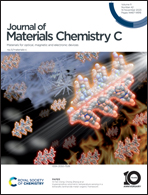Quantifying polaron densities in sequentially doped conjugated polymers: exploring the upper limits of molecular doping and conductivity†
Abstract
Conjugated polymers can be chemically tailored for a variety of electronic device applications. Sequential solution doping with high electron affinity (EA) molecular dopants is the processing technique that has produced molecularly doped polymeric films with the highest conductivity. In spite of numerous studies quantifying the conductivity of molecularly doped polymers as a function of processing conditions, there have been a limited number of studies that quantitatively compare a sweep of polaron densities in different polymer and dopant pairs. The consequence is that the relationship between conductivity, mobility, and charge density is poorly understood, prohibiting meaningful quantitative comparisons between different polymers and dopants. Here we demonstrate a practical method to quantify the polaron density using the material density, molecular volumes, and optical measurements. Importantly, this method enables quantitative comparisons between multiple polymer and dopant combinations as we demonstrate using poly-3-hexylthiophene (P3HT) and a set of diketopyrrolopyrrole (DPP) co-polymers doped with a series of ultra-high EA cyano- and ester-substituted cyclopropane-1,2,3-triylidene-based dopants. The Langmuir isotherm is used to fit the solution concentration dependence of the film polaron mole fraction, which enables characterization of the sequential doping process using a single equilibrium constant. The polaron mole fraction saturates with respect to the energetic driving force for doping, indicating that simply increasing the EA of the dopant is not an effective strategy for obtaining 100% ionization of the polymer monomers. We show quantitative consistency between this thermodynamic model and a simulated density of states (DOS) model using Gaussian energy distributions. This DOS model predicts the experimental saturated doping level for every polymer/dopant pair within uncertainty. This data and model demonstrate conclusively that the polaron density has a larger effect on increasing both conductivity and charge mobility than changes in the polymer chemistry or structure.



 Please wait while we load your content...
Please wait while we load your content...